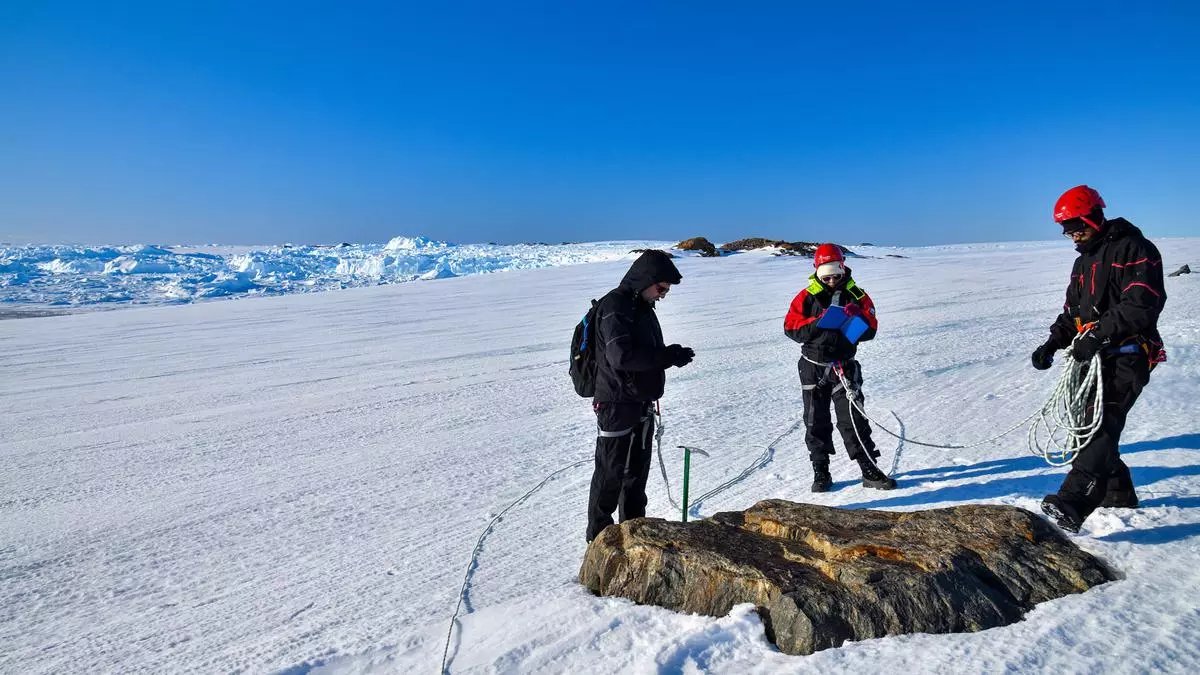There is a long and growing list of nearly 80 women researchers and doctors who are doing their bit for India’s Antarctica programme, which was launched in 1981 by then Prime Minister Indira Gandhi.
It is 13:45 hours IST, and twilight on Friday, June 2, on India’s three-storied, state-of-the-art, centrally heated Bharati station on the south polar ice sheet and glacier continent of Antarctica.
Strategically located on the same 70 degree longitude as India, Bharati in East Antarctica is just half an hour behind Indian Standard Time. But the difference could not be starker. Outside, the temperature is -22 degrees. In an hour, the polar night of this 2023 austral winter will set in, when it is dark for 20+ hours, twilight for just three hours, and the sun never rises.
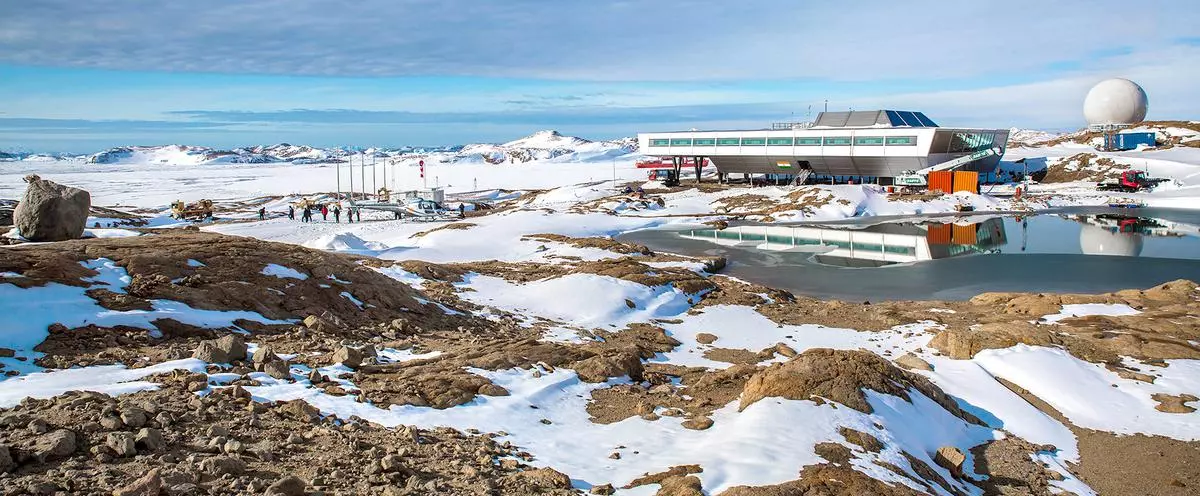
The research station Bharati in Antarctica.
| Photo Credit:
The Hindu Archives
Dr Neeraja Balakrishna (32), an MD in Anaesthesiology and Critical Care, is the medical officer on the station, catering to the medical needs of the 24 scientific and maintenance staff posted this year to run the year-round station through the isolation of a nine-month winter on this ongoing 42nd Indian Scientific Expedition to Antarctica (ISEA).
Also Read | Extent of Antarctic sea ice reached a record low in February
She has just finished her morning rounds, checking the operation theatre, the ventilator systems, and the mini hospital. Maintenance and preparedness is crucial, she tells this writer, speaking from a phone line on the station. In winter, no evacuation is possible out of the continent, not even for an emergency. Doctors from the neighbouring Russian station Vostok have in the past pitched in to help with emergency surgeries. Cooperation with neighbouring Russian and Chinese stations is the norm.
“Everyone is equal on the station, so we take turns to clean, mop, do galley duties, help in the ongoing scientific experiments in the laboratories, and take readings at the four labs in the vicinity of Bharati, as per our assignments. There is a daily morning meeting presided by the station head,” says Dr Balakrishna.
Dr Neeraja Balakrishna on the deck, just off the coast of Antarctica.
| Photo Credit:
By Special Arrangement
Once a month, Dr Neeraja provides medical backup to the eight-member team that heads 60 km out to the site of stake marker points planted by the Geological Survey of India on the Dalk Glacier, whose changing features are being measured in an ongoing 40-year-old experiment. Around 30 institutions in multidisciplinary areas, ranging from atmospheric, biological, earth sciences, glaciology, environment, human physiology and medicine, have run the Antarctica route in the past 42 expeditions.
“That’s the toughest part. It takes a day to do it and even though we are in heated Pisten Bulleys, there’s a gruelling trek on the ice shelf to the actual site on the glacier, where it is -30 degrees but feels like -40 degrees due to the wind chill. Though the station leader selects a good weather day for this, things can change suddenly to a white-out situation on the ice sheet. There’s no radio communication on this leg, so there have been times when a rescue team had to head out because the team had not returned by nightfall.”
Mission Antarctica
The many women and their work
Shipra Sinha was just 26 in 2019 and specialising in High Latitude Physics and Aurora studies at the Indian Institute of Geomagnetism (IIG). On the ISEA that year, she furthered her data collection in her areas of study, besides monitoring the data collection of 14 experiments that the IIG has been running on Maitri. Said Sinha: “Internet on Maitri is not too great, so data has to be corroborated manually to see that there is no time lapse. The IIG is associated with the World Data Centre and we have to send data to them. The main project, though, was to install an All Sky Imager at Maitri to take images of Auroras. It was a joint project with the National Institute of Polar Research, Japan, and they sent their team as well.”
Dr Cheryl Noronha-D’Mello, a sediment geochemist and palaeoclimate researcher with the NCPOR, pieces together weathering history by studying the transport of major and minor elements of the periodic table from source to sink, tracing what affected them in the past and in the present. Part of the 41st ISEA (she was also on the 39th expedition) Noronha-D’Mello (then 34) and her team stationed themselves on floating pontoons in the middle of lakes to obtain 18 sediment cores from 11 lakes of East Antarctica, near Bharati. “These cores have a time history spanning 23,000-44,000 years ago, and they are hauled back in special conditions for study at NCPOR labs here. I use enviro-magnetism and sediment geochemical tools to track changes like the impact of Glacial-Deglacial climate shifts in different palaeoperiods,” she said.
Dr Michelle Fernandes, who specialises in carbon chemistry, collected water samples from 17 East Antarctica lakes to track baseline carbon dioxide composition. “I also collected water samples for my colleagues at NCPOR who could not get berths on the voyage. I was lucky that the Research Advisory Committee accepted my proposal, and I was able to convince them about my project objectives, where my postdoctoral work also counted.”
Contracted by the National Centre for Polar and Ocean Research, the nodal institute that manages Antarctic expeditions and stations, Dr Neeraja Balakrishna will serve 15 months on Antarctica, until March 2024. With that feat, she will join the hallowed ranks of a very small number of Indian women doctors, researchers, and scientists who have spent the long, dark, and isolated winters on the continent, albeit from fully equipped winter stations now.
A national-level champion swimmer, the Bangalore-based doctor vied, in her second attempt, with 39 other doctors, four of whom were chosen for the much-coveted, prestigious, and career-defining assignment to man Maitri and Bharati, India’s two operational Antarctic stations (the first station, Dakshin Gangotri, was decommissioned when it went under ice).
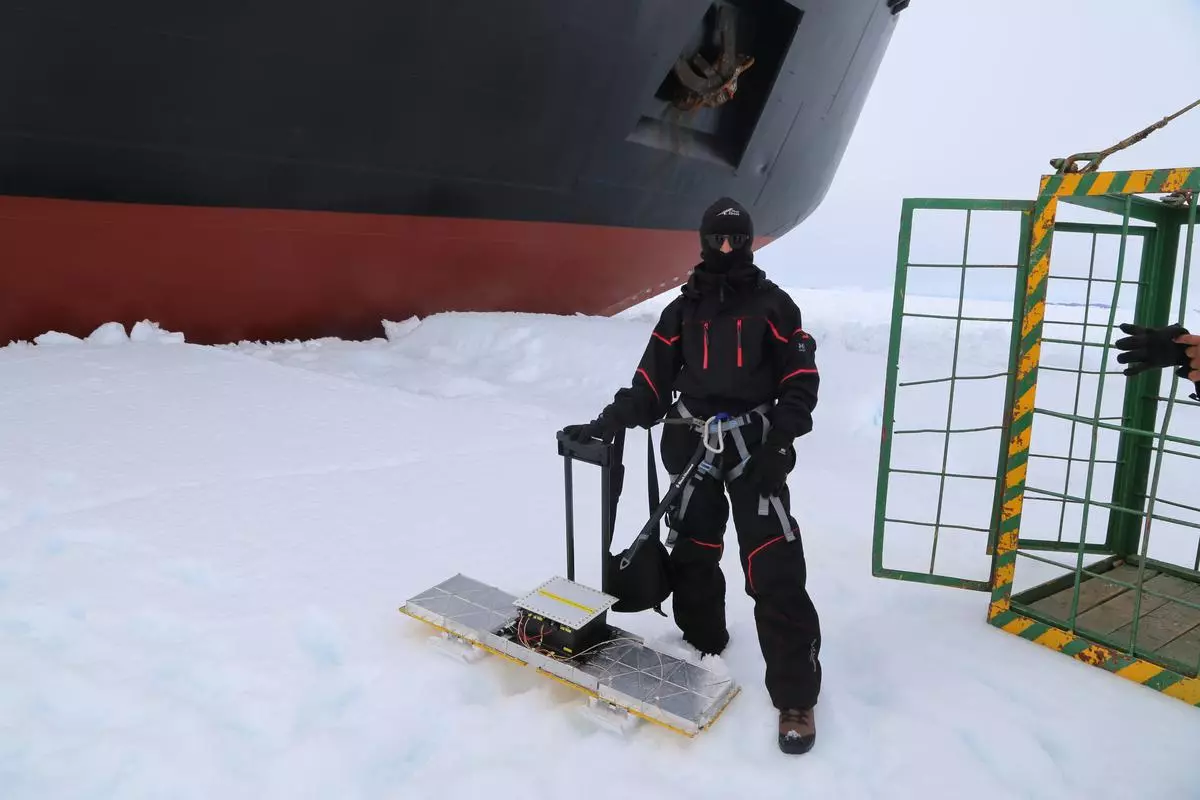
Dr Kiral Ghodadra of the Space Application Centre, ISRO.
| Photo Credit:
By Special Arrangement
It helps that her husband, Dr Siddharth Ravi, too made the mark, and the couple are part of Bharati’s medical team, along with one male nurse. “Aside from your skill sets, psychological resilience and balanced personality also matter, in order to withstand the obvious psychological effects of long periods of isolation, where you can’t leave the station and must interact with the same set of people and work as a team with them,” she explains.
Dr Balakrishna is not the first lady medic to winter on the 14 million sq km continent, four times the size of India. Dr Kanwal Vilku of the Central Government Health Services was the first woman ever to winter as a medical officer on the 19th ISEA in 1999. Dr Deviyani Nyandev Borole was on the 25th ISEA in 2005.
WATCH:
A brief history of India’s Dakshin Gangotri station in Antarctica
| Video Credit:
Reporting by Pamela D’Mello, Edited by Sambavi Parthasarathy
Indian footprint in Antarctica
All these women are part of a long and growing list of nearly 80 women researchers and doctors who are doing their bit to keep alive India’s Antarctica programme, which began with the first ISEA in 1981. Prime Minister Indira Gandhi had initiated the programme to mark India’s footprint on the continent. Before that, Indian research scientists had hitched onto two-year-long Russian expeditions.
In 1983, for the first time two Indian women scientists joined what was then a challenging expedition. It was also the year India set up Dakshin Gangotri. Indira Gandhi’s government signed the Antarctic Treaty System that year, thereby earning consultative (voting) status on the annual Antarctic Treaty Consultative Meetings (ATCM). It made India one of 29 nations with a substantial, demonstrated scientific footprint on the continent.
Mission Antarctica
The many women and their work
Rupali Pal, Scientist at the Bhabha Atomic Research Centre (BARC), measured ground level environmental radiation on the three continents of Antarctica, Africa, and Asia, besides analysing cosmic rays during the 35th ISEA. She has also investigated baseline levels of natural radioactivity in soils, rocks and lakes of Larsemann Hills in East Antarctica.
Dr Girija Rajaram of the IIG studied dramatic magnetic pattern changes (from quiet and calm to disturbed within three-hour periods) over Maitri during the 18th ISEA and demonstrated that sub Auroral regions were far better than Auroral locations to sense disturbances in Geospace and interplanetary weather.
Dr Geetha Priya M. (40), Professor at the Centre for Incubation, Innovation, Research and Consultancy (CIIRC), who was on the ISEA’S most recent, 42nd, outing, told this writer that they successfully completed 19 aerial surveys using drones fitted with multi-spectral sensors over East Antarctica; installed a Pressure Sensor Assembly in the middle of a melt pond, or surpa-glacial lake, to survey pressure and temperature dynamics of the surface melt; set up a long-range communication module that would transmit data from the mid-lake sensor directly to Maitri; and took ice motion measurements on the Nivlisen Ice Shelf using the Global Navigation Satellite System (GNSS) to track ice shelf dynamics and climate change implications.
Veteran scientists remark that science is the currency on Antarctica, though geopolitics is always present in the background. Geopolitical and commercial ambitions are kept at bay among the 46 nations that operate 70 research stations on the continent under the Protocol on Environmental Protection to the Antarctic Treaty (also known as the Antarctic-Environmental Protocol, or AEP), which India signed in 1992. The treaty keeps a cap on militarisation, waste dumping, mining, and other activities, at least until 2048, when the AEP will come up for review. When India activated its AEP participation in 1998, it also launched the Goa-based National Centre for Antarctic and Ocean Research, renamed National Centre for Polar and Ocean Research (NCPOR), which took over Antarctic operations from the National Institute of Oceanography in Goa.
Currently, it costs the NCPOR around Rs.100 crore each year to maintain the flagship Maitri and Bharati stations and run the annual ISEAs. Thrust areas of research for each ISEA are determined by a Research Advisory Committee of the Ministry of Earth Sciences (formerly the Department of Ocean Development). This committee, in turn, follows the scientific issues and research areas mapped out by the international body, the Scientific Committee on Antarctic Research (SCAR).
Highlights
- A long and growing list of nearly 80 women researchers and doctors are doing their bit to keep alive India’s Antarctica programme, which began with the first ISEA in 1981.
- Two Indian women scientists joined them for the first time in 1983, in the third ISEA.
- Over the last 15 ISEAs, a total of 56 women researchers and doctors signed up, most of them for short-term summer projects.

Dr Aditi Pant (left) and Dr Sudipta Sengupta during the third ISEA in December 1983.
| Photo Credit:
The Hindu Archives
Women in expeditions
Much has changed in both the travel and the technology logistics of accessing, surviving, and managing on Antarctica, since Dr Aditi Pant, oceanographer at the National Institute of Oceanography, and Dr Sudipta Sengupta, geologist from Jadavpur University, joined the third ISEA way back in 1983.
Sengupta grew up in Nepal, where her meteorologist father was based, was an accomplished mountaineer, and had done geological studies in the Arctic areas during a stint at Sweden’s Uppsala University. Both these factors weighed in her favour and she was part of the Antarctic missions led by Dr Syed Zahoor Quasim, the then Secretary of the Department of Ocean Development. She went on to carry out widely published research in the Schirmacher Hills in East Antarctica.
Mission Antarctica
The many women and their work
Neelu Singh of the Forest Research Institute, in 2009 (28th ISEA), assessed dissolved mercury content, collecting water samples from 15 freshwater lakes in the Schirmacher Hills area and from 15 lakes in the Larsemann Hills area near Maitri and Bharati stations, which are 100 km apart.
Roseline C. Thakur, also of the FRI, in 2009, analysed the presence of trace elements in the aerosols near the stations to map climate change effects in that sensitive high latitude area.
Vartika Singh of the Birbal Sahni Institute of Palaeosciences (BSIP) collected sediment and water samples to assess climate change impact of microfossils for palaeoenvironmental reconstruction.
Prof. Laxmi Bishnoi of the National Physical Laboratory has worked on characterising the marine and atmospheric boundary layer over East Antarctica, a process that helps understand communication problems faced over marine environments.
Pant was a trekker and hiker, with a masters from the University of Hawaii, where she studied photosynthesis in plankton communities, and a doctorate from London University in the physiology of marine algae. She returned to the National Institute of Oceanography and conducted studies on Antarctic Phytoplankton on her maiden expedition, returning again for the 5th expedition to research primary and extracellular production during Antarctica’s austral summer.
In the 27 years between the first ISEA in 1981 and the 27th ISEA in 2007, just 24 women scientists joined the expeditions. The challenges then were daunting and came with risks that claimed lives. Up until the 10th ISEA in 1990, families of Antarctica expeditioners congregated for scratchy calls at the Department of Ocean Development that came via a hotline from the lone station. Now, both stations have Wi-Fi from a 2 mbps line, where email always works even when the connection is poor, says Dr Shailendra Saini, Group Director, Antarctic Operations at the NCPOR.
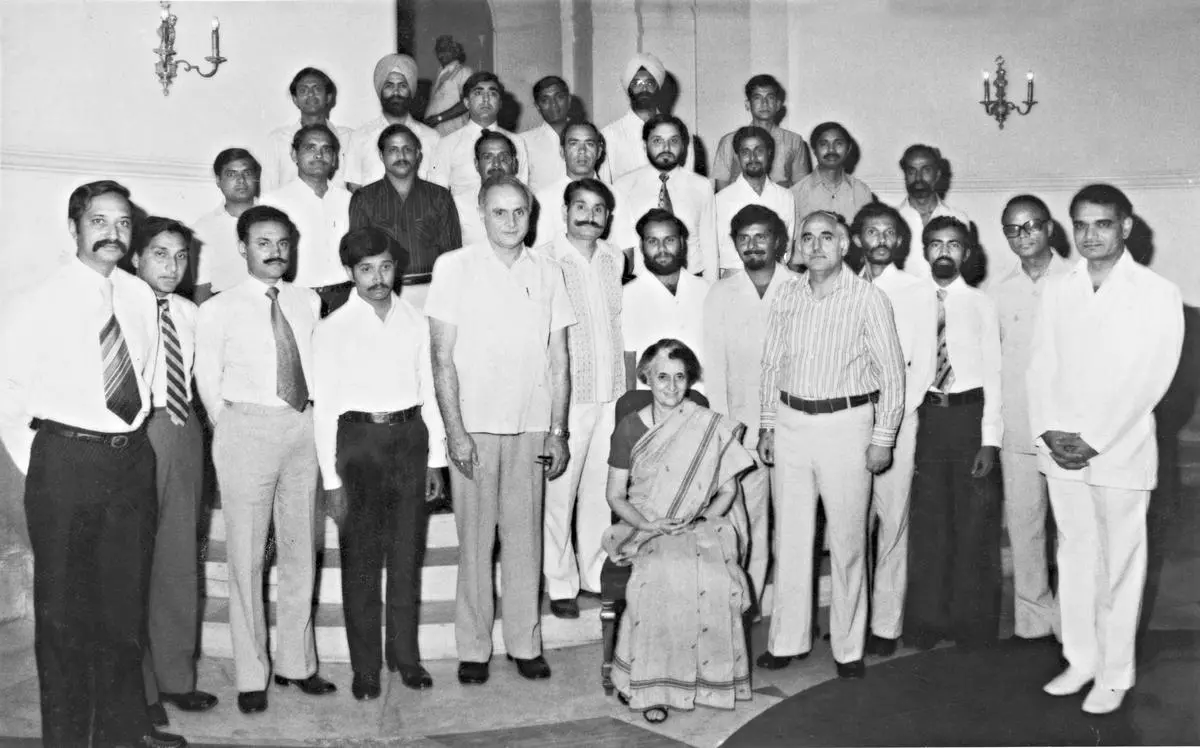
Prime Minister Indira Gandhi with the members of the second successful Indian expedition to Antarctica, in New Delhi in May 1983.
| Photo Credit:
The Hindu Archives
Air operations commenced in 2007 and was a game changer, opening up the field. Earlier, expeditions involved more than a month-long sea voyage from Goa to Cape Town, and from Cape Town to Antarctica in ice-breakers. Researchers now fly in for short-term summer projects as and when required, while logistical staff are hired by NCPOR to keep the stations running during winters.
Over the last 15 ISEAs, a total of 56 women researchers and doctors signed up, most of them for short-term summer projects, contributing mainly in biological- and environment-related sciences, and in ice projects, studying glaciological and geological features, collecting soil, water and sediment samples for analysis. The NCPOR has sent 13 women doctors and 15 researchers on expeditions so far. Participation increased when the expeditions’ composition changed since the 25th ISEA. Support staff now come more from civilian ranks, and some experienced ex defence Antarctica veterans.
The construction and commissioning of the Bharati station in 2012 saw increased involvement from ISRO’s National Remote Sensing Centre, and Space Applications Centre. ISRO has deputed 17 women scientists since then, including Madhulika P., who did a long winter-over.
In fact, Indian women researchers have worked on a wide range of subjects on the world’s only continent with no native human population. And, increasingly, younger researchers and PhD students are making the cut as the age demographic drops and India’s status as an emergent power in polar science research progresses.
Trends in Women’s participation
“To me, working in Antarctica is like working in any other field work. I treat it as the same office environment and get on with my work, though, undoubtedly it is a singular experience. Of course, there’s the cold, but we are provided excellent kits. And one has to be flexible and accommodative. I’ve bunked on the ship, in the comfort of the station, and sometimes in a container sleeping module, where the heating may not be the best—wherever one is assigned. It goes with the territory,” said Gautami Dev Samui, ex-NCPOR scientist and possibly the only woman researcher to go on the ISEA three times.
Samui was part of the NCPOR’s Cryosphere Science Division and, along with fellow researcher Runa Anthony, collected samples from cryoconite holes on three glaciers.
Mission Antarctica
The many women and their work
Dr P.A. Loka Bharathi and the team of the National Institute of Oceanography who were part of the 13th ISEA in 1993-94 used an underwater radiometer to profile the ozone hole UV radiation and assess and compare primary production of surface and column chlorophyll in phytoplankton communities in Antarctic waters near 15 stations and six temperate ocean water sites during the expedition’s ocean voyage.
Preeti Oswal of the National Botanical Research Institute (NBRI) conducted pilot experiments and field observation of lichen ecology during the 25th ISEA.
Dr Binita Phartiyal of BSIP analysed water samples from 30 lakes, as well as sediment samples and 10 sediment cores to assess the climatic history and landscape evolution of the Schirmacher Oasis.
Sonal Pande, an IIT Bombay MTech master’s student in environmental science and engineering in 2014-15, was, at 24, the youngest among 40 researchers on Maitri during the summer of the 34th ISEA. Her thesis involved ground measurement of air quality around Maitri and comparing it with the air quality in Nasik and Pune. “The 24-hour daylight during the Antarctic summer can be disorienting. But everyone was very protective and supportive and never let me go out in blizzards alone. There was already a great rapport within the team since everyone had bonded very well during pre-Antarctica expedition training at the Mountaineering and Skiing Institute of the Indo Tibetan Border Police, in Auli, Uttarakhand”, she told this writer.
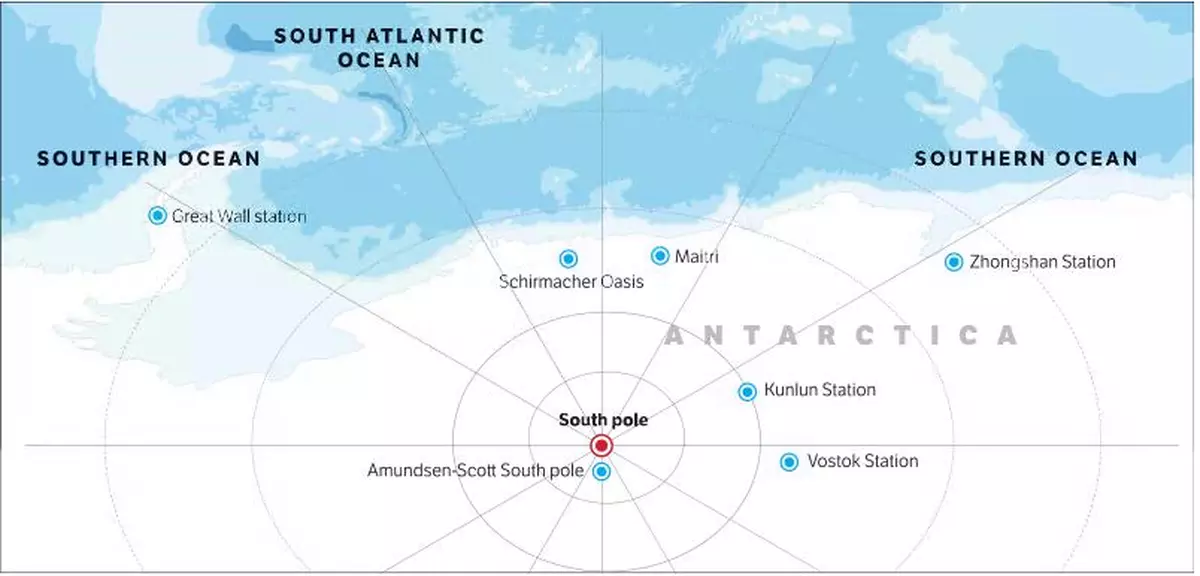
Dr Sharda Sundaramurti, a surgeon, fulfilled a lifelong ambition when, aged 31, she was picked from 50 other medics at a walk-in interview as summer voyage medical officer on the 39th ISEA. “The emphasis was on safety and prevention of hypothermia. But it was 2019-20, and COVID-19 had hit. We were on a ship, with no Internet, with information and misinformation trickling in. The Russian crew had their doctor on board and, between us, we had to keep the panic down,” she said. They were locked down in a Capetown hotel for a month and half, before returning on a Vande Bharat rescue.
Also Read | Year of centenaries
On the 39th ISEA in 2019, Nilanjana Sorcar, research scientist in metamorphic petrology and geochemistry from the National Centre for Earth Science Studies (NCESS), investigated pelitic granulites from the Storness Peninsula, Prydz Bay area of Princess Elisabeth Land in East Antarctica. Her findings, published in a research paper, confirmed that the Prydz Bay area was juxtaposed to the Eastern Ghats Province of India during the Assembly of East Gondwana in the late Neoproterozoic to Cambrian periods around 550-500 Ma (million years ago). long and growing list of nearly 80 women researchers and doctors who are doing their bit to keep alive India’s Antarctica programme, which began with the first ISEA in 1981.
With more than a lakh people likely to be visiting Antarctica in 2023 on cruise ships and long haul polar over-flights, as a contentious but lucrative tourism business gets stronger, Antarctica is no longer the inaccessible final frontier it once was.
Pamela D’Mello is an independent journalist who writes for print and online platforms. Based in Goa, her work spans politics, environment, business, and society.

